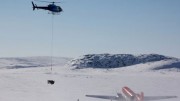Ten weeks into 2015, and many of the world’s iron ore miners are on edge as iron ore prices set new lows, and the finger-pointing begins as to who is contributing to the problems besetting the industry.
At press time on March 11, the price for iron ore had sunk below US$60 per tonne, with the spot price for iron ore landed in China dropping another 1.5% to US$58.58 per tonne, its lowest level since spot records started in 2009.
For now, if you don’t look at the billions knocked off market caps, that scenario is fine for ultra-low cost producers such BHP Billiton and Rio Tinto at their Australian mines, but it’s leaving the rest of the industry gasping to avoid going out of business.
With commodity prices tending in the long run to trend just slightly above their cost of production, many analysts are now running a US$50-per-tonne model through their spreadsheets, and the resulting cash flow crunch awaiting most of the iron ore industry is not pretty.
Disturbingly for iron ore’s prospects, after so many years of booming steel production in China that spawned a seemingly insatiable hunger for iron ore, coking coal and nickel, Chinese steel production looks to be on track to shrink this year as consumption peaks and more steel mills are shut down.
The China & Iron Steel Association predicts steel production in China will contract to 814 million tonnes in 2015 from 823 million tonnes last year, owing to the slowdown in the country’s construction industry and a government clampdown on pollution.
By contrast, the iron ore majors are predicting China’s steel output will peak next decade, and plan to increase iron ore output accordingly. Bloomberg calculates that net iron ore supplies could rise by 60 million to 75 million tonnes in 2015, compared to a 75-million increase in 2014, as expansions in Australia and Brazil more than offset closures in China. It projects global seaborne supply to increase 4.6% this year to 1.4 billion tonnes.
As a winner of the iron ore producers’ war, BHP Billiton is nothing if not exceptionally bullish on the performance of its Western Australia Iron Ore business (WAIO). In the lead-up to the annual Global Iron Ore and Steel Forecast Conference in Perth, BHP Billiton president of iron ore, Jimmy Wilson, described his unit’s “robust financial and operating results despite the challenging market conditions,” with cash costs per tonne in the first half of fiscal 2015 dropping to a mere US$20.35 per tonne, down from a US$28.80 per tonne a year earlier, and an underlying EBIT margin of 49% and a return on assets of 34%.
He reiterated that WAIO is on track to achieve unit cash costs of less than US$20 per tonne “through a relentless pursuit of equipment availability and utilization, efficient procurement and supply management, and capital and workforce productivity,” with WAIO poised to deliver 245 million tonnes in BHP’s 2015 financial year on a 100% basis.
Rio Tinto, which tabled a stellar 78% increase in annual profits to US$6.5 billion in 2014, set iron ore production records last year and enjoyed remarkable cash costs at its Australian iron ore mines of just US$18.7 per tonne in the second half of 2014.
On a 100% basis, Rio Tinto’s iron group produced record sales of 302.6 million tonnes in 2014, up 17% from 2013, with 2015 production from the Pilbara on a 100% basis due to rise to 330 million tonnes.
The other iron ore majors are not doing nearly as well, though Anglo American is buffered somewhat from the fall in iron ore prices by the exceptional performance of its De Beers diamond subsidiary.
Vale, the world’s largest iron-ore producer, reported a fourth-quarter loss of US$1.9 billion, compared with a year-earlier loss of $6.5 billion, as it sold iron ore for 45% less than a year earlier.
And after having widely announced its desire to move out of Canada, iron ore and coal miner Cliffs Resources is seeking get out of the seaborne trade altogether and sell its Australian iron assets to focus on supplying the U.S. market, where steel production is still growing. (In fact, trying to visit the “Asia Pacific Iron Ore” asset webpage on Cliffs’ website leads to an “HTTP 404 Not Found” error message!)
Cliffs’ Asia Pacific unit was due to produce 11 million tonnes in 2015, with cash costs in the fourth quarter coming in at US$42.90 per tonne, down 25% from US$57.52 per tonne a year earlier.



Be the first to comment on "Editorial: No end in sight for iron ore glut"